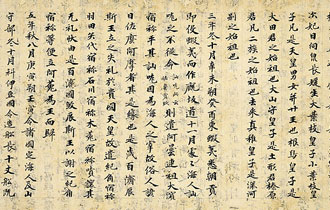Pages |
In other words, the constitution (still in effect today) prohibits Japan from fighting wars or having military forces, even for defensive purposes.
Conservative critics of Article 9 argue that it does not preclude defensive wars or armaments. Public opinion polls show that the Japanese public overwhelmingly rejects efforts to amend the constitution to allow Japan to arm and fight; in fact, one of the salient characteristics of post-World War II Japanese is their commitment to an anti-nuclear, peace culture.
The Reverse Course
Although it is hard to pin down exactly when it began, sometime in mid-occupation, SCAP began to carry out the so-called "reverse course," that is, it changed directions from the democratizing reforms of the early occupation to a policy of rebuilding Japan economically as an American ally. A combination of the American conflict with the Soviet Union in Europe and elsewhere, the rise of Mao Tse-tung and the Chinese Communist Party to power in China, the anti-government/anti-occupation attitudes of many of Japan's fledgling labor unions, and in June 1950, the onset of the Korean War, led the government in Washington and SCAP in Tokyo to see Japan as an important Cold War bulwark against the perceived threat of communism. Rather than continue the radical reforms of the early occupation, SCAP turned increasingly to conservative leaders like Yoshida Shigeru, who were willing to allow the United States to use Japan as a military base in return for help in rebuilding Japan's crippled industrial economy.
On July 14, 1950, only two weeks after the outbreak of war in Korean, Prime Minister Yoshida, leader of a country still under occupation and thus not sovereign, made a speech in which he pledged his government's complete support to the United Nations forces on the Korean peninsula. Japan's role in the Korean War, which lasted until July 1953, was crucial both to the United Nations' success in stemming the tide of the North Korean invasion, and in Japan's subsequent economic miracle. The United Nations' military, in this case, United States' fighters and bombers, flew hundreds of combat missions over Korea from its "unsinkable aircraft carrier," the Japanese archipelago. Japan became a critical intermediate staging area for troops, weapons and supplies from the United States destined for the Korean conflict. And Japanese enterprises received millions of dollars in contracts to supply everything from food and clothing to trucks and other war goods produced under licensing agreements with American companies. The skilled, but still inexpensive Japanese workforce was crucial to America's war efforts in Korea.
The Korean War was a godsend to conservative politicians like Yoshida. It allowed them to pursue anti-communist repression in Japan and support Japan's industrial enterprises in rebuilding its economy-with both Washington's and SCAP's wholehearted support. In early June 1950, even before war erupted in Korea, General MacArthur, with Yoshida's agreement, purged top leaders of the Japan Communist Party, banned publication of the JCP's newspaper, Akahata (Red Flag), had thousands of party members dismissed from jobs both in the public and private sectors, and rehabilitated a number of individuals who had been purged as militarists in the early days of the Occupation-these activities intensified after the Korean War began in late June. The war and its procurement activities set off the Japanese economic "miracle." Not only did the United States buy many of its war goods in Japan, but it also took the lead in reintroducing Japan to the world's political and economic order; with U.S. support, Japan joined the United Nations in 1956, became the second largest borrower from the World Bank by the late 1950s, and was recognized as an advanced industrial country when it joined the Organization for Economic Cooperation and Development in 1964. From 1952 until 1978, Japan's economy grew by 8.4% per year; over this quarter of a century, Japan maintained full employment and real wages rose by over half of that growth rate.
Pages |











